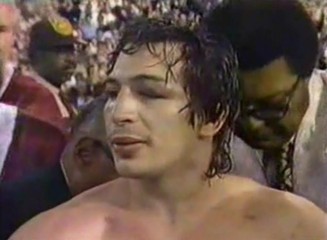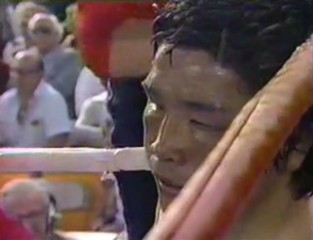 13.11.07 – By Matthew hurley: Tonight ESPN Classic presents Triumph And Tragedy – The Ray Mancini Story at eight o’clock. The hour long documentary will cover the tragic bout between Mancini and the doomed Deuk Koo Kim that took place on November 13th, 1982 for Mancini’s World Boxing Association lightweight title. The repercussions of that day, beneath a hot blazing sun and broadcast on CBS, are still being felt in the boxing world today.
13.11.07 – By Matthew hurley: Tonight ESPN Classic presents Triumph And Tragedy – The Ray Mancini Story at eight o’clock. The hour long documentary will cover the tragic bout between Mancini and the doomed Deuk Koo Kim that took place on November 13th, 1982 for Mancini’s World Boxing Association lightweight title. The repercussions of that day, beneath a hot blazing sun and broadcast on CBS, are still being felt in the boxing world today.
Going into the fight Ray “Boom Boom” Mancini, from Youngstown, Ohio had established himself as a marketable boxing star. He was a fighter on the cusp of transcending the sport and being embraced by the Hollywood glitterati. He had won the title on a first round knockout over Arturo Frias and had made one successful title defense against Ernesto Espana, stopping him in the sixth round.
Deuk Koo Kim, from South Korea, was measurably unsuited for the number one ranking by the WBA. But the sanctioning body propelled him to the top of the ranked contenders and allowed him to step into the ring with the surging Mancini. Apparently it didn’t matter that the fighter remained untested and after compiling a record of 17-1-1 he had only scored one knockout in his professional career. Still, the fighter himself defined the word used to describe his trade. He was a fighter whose heart commanded him to move ever forward in the ring no matter what was stacked up against him. In this instance it was a champion who was simply much too experienced, too strong and too good for him.
 In the tragic aftermath it was discovered that Kim had written, “live or die” on his hotel lamp shade. The news media then changed the translation to “kill or be killed.” The irony of those words would be realized four days after the bout when the little fighter from South Korea succumbed to the injuries he sustained in the ring that day in November. He had given his all for fourteen rounds but finally fell and then passed into a dark chapter in boxing’s history. Sports Illustrated would later publish a photo of the fight on its cover under the heading Tragedy In The Ring.
In the tragic aftermath it was discovered that Kim had written, “live or die” on his hotel lamp shade. The news media then changed the translation to “kill or be killed.” The irony of those words would be realized four days after the bout when the little fighter from South Korea succumbed to the injuries he sustained in the ring that day in November. He had given his all for fourteen rounds but finally fell and then passed into a dark chapter in boxing’s history. Sports Illustrated would later publish a photo of the fight on its cover under the heading Tragedy In The Ring.
Many things changed after Kim’s death. The first, and most substantial, was the WBC’s ruling that all of its title fights would now be contested over twelve rounds. In the years to come the other sanctioning bodies would follow suit. It also marked a shift in the general public’s perception of the sport of boxing that hadn’t been seen since Emile Griffith knocked out Benny “Kid” Paret on national television in 1962 on the Friday Night Fights program. Paret slipped into a coma after being pummeled in the twelfth round and succumbed ten days later. It would be several years before boxing would be on national television again. With the death of Kim a boxing backlash immediately sprung up and it has remained ever since – sometimes it is loudly vocal and then it is muted after a particularly inspiring bout only to surface again when boxing abolitionists find fodder to feed on. One of the more recent incidents being the death of Leavander Johnson in 2005.
Mancini struggled with Kim’s death and his career seemed to pass over the arc and descend into his eventual retirement. The guilty feelings were exacerbated four months later when Kim’s mother committed suicide. Then, on July 1st, the referee for the bout, Richard Greene, also committed suicide.
In South Korea Kim’s life became the subject of a feature film entitled Champion directed by Kwak Kyung Taek and staring actor Yu Oh Seong. The movie will air on ESPN classic after The Ray Mancini Story.